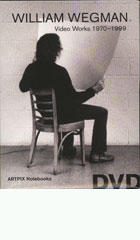
William Wegman: Video Works 1970-1999 2006
Distributed by Microcinema International/Microcinema DVD, 1636 Bush St., Suite #2, SF, CA 94109; 415-447-9750
Producer n/a
Directed by William Wegman
DVD, b& and color, 3 hrs, 56 min.
Jr. High - Adult
Art, Humor, Media Studies, Popular Culture
Date Entered: 09/11/2006
Reviewed by Meghann Matwichuk, Morris Library, University of DelawareBest known for his whimsical photographic portraits of Weimaraners, William Wegman’s humor, both light-hearted and ironic, is at its most subversive in his video works. This DVD set presents three decades of his decidedly low-tech video pieces, showcasing the comic potential of everyday objects as well as his collaborative relationship with his inimitable pups (most notably his first canine companion, Man Ray). A lengthy and informative essay written by art historian Kim Levin accompanies the DVD set, delineating those qualities which set Wegman apart from his contemporaries.
The videos are presented in reels of a dozen or more short clips, most of which clock in with a running time of a minute or less. They rely on innovative visual, textual, and / or verbal gags and mostly star the artist himself. Those that feature his unendingly patient collaborator and muse Man Ray are among the most entertaining. Man Ray’s stoic attempts to make sense of his master’s absurd actions and verbal cues are at once endearing and ridiculous. They’re also laugh-out-loud funny. Some of the words that have been used to describe Wegman’s work include silly, inconsequential, and sentimental. These are also the qualities that make him perhaps the most accessible of conceptual artists. While recently attending a multimedia exhibition of Wegman’s work I noticed a sound that’s not usually heard in the hushed and hallowed halls of the art museum -- laughter erupting in delighted bursts throughout the gallery. For many, video art follows the precedent set by the likes of Andy Warhol, whose sensibilities veer towards what Levin refers to as “the aesthetic of boredom”. Wegman’s videos are too compact, too goofy, and too surprising to inspire boredom. Even when the videos lack an obvious punch line, they lend a sense of bemused puzzlement that mirrors the eager attention given so unfailingly by Man Ray in Wegman’s early work.
The works also trace the arc of the developing video medium, shot first in stark black and white, up through the advent of color video and rudimentary video editing. Technique and performance preclude form, giving the works a deceptively amateur feel. Wegman’s compositions consist of simple props (a cookie jar, a light stand, a dog, or Wegman himself) and are presented without artifice. This post-minimalist canvas sets forth an adventurous hodgepodge of process, language, and performance that will fascinate both the serious art student and the layperson who may only be familiar with Wegman’s work from his greeting cards and children’s videos. Thus the video is highly recommended for academic and public libraries alike.